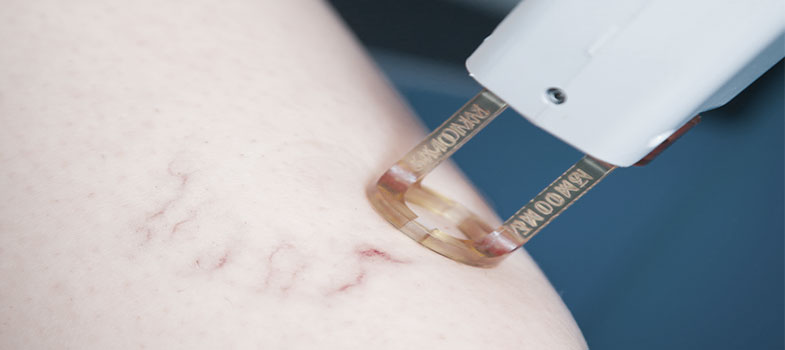
Spider veins

Small blue or red veins that run superficially under the skin are called spider veins. Spider veins are veins that become visible in a net shape or as spots due to the loss of their elasticity.
The causes of the loss of elasticity are mainly genetic. However, hormonal changes, e.g. during pregnancy, obesity or lack of exercise, can promote the development of spider veins. Weak connective tissue in particular is considered the main cause, which is why women are affected more often than men.
How do spider veins develop?
Responsible for the development is usually excessive pressure in the blood vessels, such as high blood pressure. This causes vasodilatation, and long periods of sitting or standing also prevent blood from flowing back, which can cause spider veins in the long term. Spider veins mainly appear on the legs, especially on the lower and upper thighs as well as on ankles and are harmless to health. If deeper varicose veins can be excluded after an examination of the vessels, we recommend sclerotherapy of the spider veins.
At a Glance
Technical term: spider veins or telangiectasias (special subtype of varicosis)
Type of anesthesia: none or anesthetic cream
Procedure duration (treatment time): 10-15 minutes
Hospital stay: outpatient
Aftercare: compression bandage and compression stockings
Fit for social life: immediately
Fit for work: immediately
Rest period: none
Procedure
Depending on where the spider veins appear, they are perceived as extremely disturbing. A proven method of removing the enlarged veins is sclerotherapy. In this treatment method – also called sclerotherapy – a special sclerosing agent is injected into the spider veins. This is done through a fine cannula, so the treatment is very painless. The special agent irritates the vessel walls, causing them to stick together and the vein to close. Thus, the vein is no longer visible and, moreover, it becomes unusable. It is gradually eliminated by the body’s own degradation processes.
After-effects
Side effects and complications after sclerotherapy of spider veins occur only in rare cases. Allergic reactions to the sclerosing agent are also rare and can be ruled out by examinations prior to treatment. Small bruises are possible due to the injection. Slight swelling and redness may also occur due to the inflammation of the vein, but these usually disappear completely after a few weeks. The sclerotherapy should always be performed by trained physicians, since the exact injection as well as the appropriate amount of sclerosant are of great importance in order not to affect the surrounding area.
Aftercare
Sclerotherapy does not require a rest period, which is why you will be able to return to full social and work activities shortly after the treatment. Following the treatment, a compression bandage should be worn for the next three days. In this way, an ideal result can be promoted. In the following weeks, it is sometimes advisable to wear compression stockings. This can be discussed with the attending physician. Compression stockings as well as sufficient exercise, alternating showers and cooling of the legs after long periods of sitting or standing also prevent the development of further spider veins.









